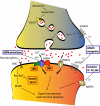From synapse to nucleus: novel targets for treating depression - PubMed (original) (raw)
Review
From synapse to nucleus: novel targets for treating depression
Herbert E Covington 3rd et al. Neuropharmacology. 2010 Mar-Apr.
Abstract
The need for newer compounds to treat depression is an ever-growing concern due to the enormous societal and financial ramifications of this disorder. Here, we review some of the candidate systems that could potentially be involved in depression, or an inherent resistance to depression termed resilience, and the numerous protein targets for these systems. A substantial body of literature provides strong evidence that neurotrophic factors, glutamate receptors, hypothalamic feeding peptides, nuclear hormone receptors, and epigenetic mechanisms, among others, will make for interesting targets when examining depressive behavior or resilience in preclinical models, and eventually clinical trials. Although some of these targets for depression already appear promising, new waves of more selective compounds for any molecular system should promote a better understanding of this complex disease and perhaps improved treatments.
Copyright 2009 Elsevier Ltd. All rights reserved.
Figures
Figure 1
Emerging antidepressant targets from neurotrophic and glutamatergic signaling pathways. Negative modulators of downstream neurotrophic signaling acting at SPROUTY and SPRED protein families represent potential mechanisms for increasing neurotrophic function. AMPA receptor potentiators and NMDA receptor allosteric modulators (with specific subunit selectivity) are now in clinical trials. Allosteric modulators of mGluRs are also being explored in preclinical studies. Modulators of AMPA receptor expression and function, such as TARPs and CNIH, represent potential therapeutic targets as well. Compounds under development for their antidepressants effect are shown in blue boxes. New target proteins are highlighted in red boxes. CNIH, cornichon homolog; MAPK, mitogen-activated protein kinase; RTK, receptor tyrosine kinase; TARP, transmembrane AMPAR regulatory proteins; VGLUT, vesicular glutamate transporter.
Figure 2
Portrayed here is a molecular pathway analysis of genes regulated in the mouse nucleus accumbens by a direct infusion of the HDAC inhibitor MS-275 after chronic social defeat stress. Infusion of MS-275 promotes antidepressant-like behavioral responses and significantly regulates genes as revealed by microarray analysis. Examples of highly regulated molecular pathways that may provide novel targets for treating depression include genes that encode presynaptic vesicular proteins, plasma membrane receptors, intracellular signaling molecules, proteins that regulate the actin cytoskeleton, and the transcriptional regulatory machinery. Reprinted with permission from The Journal of Neuroscience (Covington et al., 2009).
Similar articles
- GABA and glutamate systems as therapeutic targets in depression and mood disorders.
Kendell SF, Krystal JH, Sanacora G. Kendell SF, et al. Expert Opin Ther Targets. 2005 Feb;9(1):153-68. doi: 10.1517/14728222.9.1.153. Expert Opin Ther Targets. 2005. PMID: 15757488 Review. - The missing link between clinical endpoints and drug targets in depression.
Della Pasqua O, Santen GW, Danhof M. Della Pasqua O, et al. Trends Pharmacol Sci. 2010 Apr;31(4):144-52. doi: 10.1016/j.tips.2009.12.004. Epub 2010 Feb 1. Trends Pharmacol Sci. 2010. PMID: 20117847 - Reshaping the Depressed Brain: A Focus on Synaptic Health.
Gerhard DM, Ross DA. Gerhard DM, et al. Biol Psychiatry. 2018 Dec 1;84(11):e73-e75. doi: 10.1016/j.biopsych.2018.09.028. Biol Psychiatry. 2018. PMID: 30409269 Free PMC article. No abstract available. - Advances in novel molecular targets for antidepressants.
Wang Q, Dwivedi Y. Wang Q, et al. Prog Neuropsychopharmacol Biol Psychiatry. 2021 Jan 10;104:110041. doi: 10.1016/j.pnpbp.2020.110041. Epub 2020 Jul 16. Prog Neuropsychopharmacol Biol Psychiatry. 2021. PMID: 32682872 Free PMC article. Review. - Targeting the Neuronal Activity of Prefrontal Cortex: New Directions for the Therapy of Depression.
Zhou XT, Bao WD, Liu D, Zhu LQ. Zhou XT, et al. Curr Neuropharmacol. 2020;18(4):332-346. doi: 10.2174/1570159X17666191101124017. Curr Neuropharmacol. 2020. PMID: 31686631 Free PMC article.
Cited by
- Blues in the Brain and Beyond: Molecular Bases of Major Depressive Disorder and Relative Pharmacological and Non-Pharmacological Treatments.
Maffioletti E, Minelli A, Tardito D, Gennarelli M. Maffioletti E, et al. Genes (Basel). 2020 Sep 18;11(9):1089. doi: 10.3390/genes11091089. Genes (Basel). 2020. PMID: 32961910 Free PMC article. Review. - Administration of memantine and imipramine alters mitochondrial respiratory chain and creatine kinase activities in rat brain.
Réus GZ, Stringari RB, Rezin GT, Fraga DB, Daufenbach JF, Scaini G, Benedet J, Rochi N, Streck EL, Quevedo J. Réus GZ, et al. J Neural Transm (Vienna). 2012 Apr;119(4):481-91. doi: 10.1007/s00702-011-0718-2. Epub 2011 Sep 28. J Neural Transm (Vienna). 2012. PMID: 21953515 - The Antidepressant-like Effects of Estrogen-mediated Ghrelin.
Wang P, Liu C, Liu L, Zhang X, Ren B, Li B. Wang P, et al. Curr Neuropharmacol. 2015;13(4):524-35. doi: 10.2174/1570159x1304150831120650. Curr Neuropharmacol. 2015. PMID: 26412072 Free PMC article. Review. - Antidepressant action of ketamine via mTOR is mediated by inhibition of nitrergic Rheb degradation.
Harraz MM, Tyagi R, Cortés P, Snyder SH. Harraz MM, et al. Mol Psychiatry. 2016 Mar;21(3):313-9. doi: 10.1038/mp.2015.211. Epub 2016 Jan 19. Mol Psychiatry. 2016. PMID: 26782056 Free PMC article. - 5-HT2A Receptor Knockout Mice Show Sex-Dependent Differences following Acute Noribogaine Administration.
Villalba S, González B, Junge S, Bernardi A, González J, Fagúndez C, Torterolo P, Carrera I, Urbano FJ, Bisagno V. Villalba S, et al. Int J Mol Sci. 2024 Jan 5;25(2):687. doi: 10.3390/ijms25020687. Int J Mol Sci. 2024. PMID: 38255760 Free PMC article.
References
- Aan Het Rot M, Collins KA, Murrough JW, Perez AM, Reich DL, Charney DS, Mathew SJ. Safety and efficacy of repeated-dose intravenous ketamine for treatment-resistant depression. Biol Psychiatry. 2009 in press. - PubMed
- Ahokas A, Kaukoranta J, Wahlbeck K, Aito M. Estrogen deficiency in severe postpartum depression: successful treatment with sublingual physiologic 17beta-estradiol: a preliminary study. J Clin Psychiatry. 2001;62:332–336. - PubMed
- Alt A, Weiss B, Ornstein PL, Gleason SD, Bleakman D, Stratford RE, Jr., Witkin JM. Anxiolytic-like effects through a GLUK5 kainate receptor mechanism. Neuropharmacology. 2007;52:1482–1487. - PubMed
- Bacchi F, Mathe AA, Jimenez P, Stasi L, Arban R, Gerrard P, Caberlotto L. Anxiolytic-like effect of the selective neuropeptide Y Y2 receptor antagonist BIIE0246 in the elevated plus-maze. Peptides. 2006;27:3202–3207. - PubMed
Publication types
MeSH terms
Substances
LinkOut - more resources
Full Text Sources
Medical

